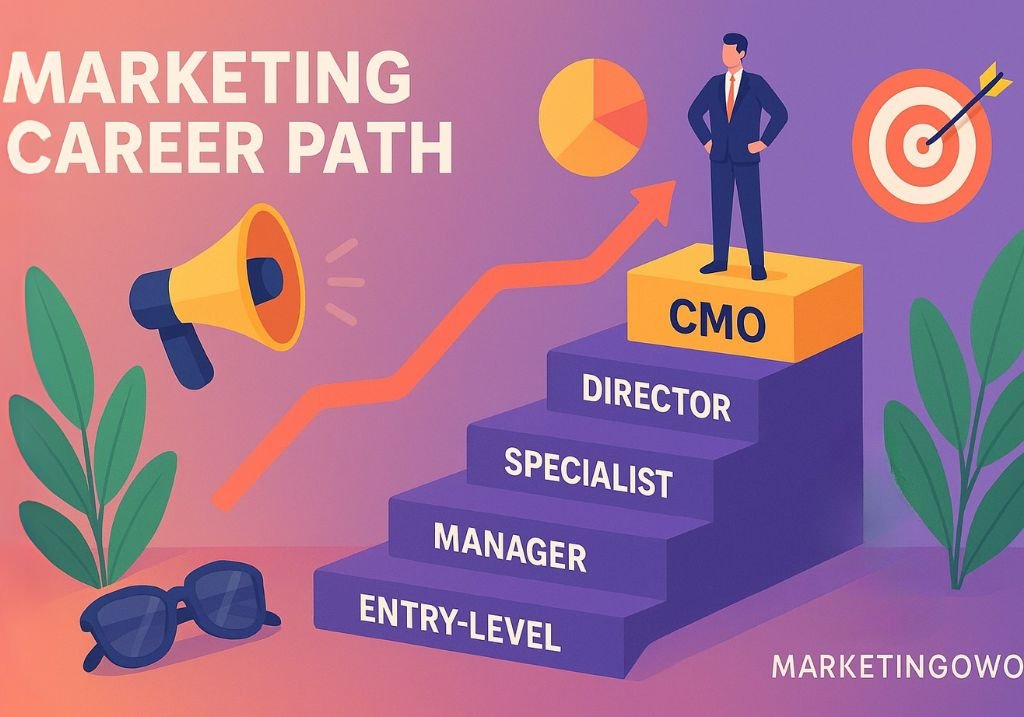Embarking on the marketing career path means charting a course from junior roles up to the C-suite. This guide immediately answers your query by mapping out how you can grow in marketing: we’ll outline the progression from entry-level positions (e.g. Marketing Coordinator, Content Specialist) through mid-level roles (e.g. Marketing Manager, SEO Strategist) and into leadership (Director of Marketing, VP, and Chief Marketing Officer). Along the way, we’ll highlight the technical, analytical, and leadership skills you’ll need at each stage. You’ll also find real advice from seasoned U.S. CMOs and practical tips—such as key certifications and networking strategies—to help advance your career. By the end, you’ll understand exactly how to navigate your marketing career path and what it takes to reach the top.
Understanding the Marketing Career Path
The marketing career path is typically a series of roles with increasing responsibility and scope. In the U.S. marketing industry today, professionals often start in specialist or coordinator roles, then move into managing campaigns or teams, and finally into strategic leadership roles. In practice, there’s no single, linear track — every marketer’s journey is unique. However, the general progression flows from hands-on execution (like running a campaign or managing social media) to strategy and leadership (shaping brand vision and budgets).
A key trend is that marketing skills are constantly evolving. According to industry reports, “human” skills — notably communication, innovation, and adaptability — remain critical even in an automated age. In fact, LinkedIn’s 2024 Marketing Jobs Outlook highlights that collaborative problem-solving and other human skills are more important than ever for marketers. At the same time, technical competencies like digital marketing, data analytics, and SEO are essential building blocks. By mastering both the soft skills and hard skills relevant to marketing, you set yourself up for steady advancement along your career path.
Below, we break down the entry-level, mid-level, and leadership stages of a typical marketing career path, describe the skills needed at each, and offer advancement tips along the way.
Entry-Level Marketing Roles
Entry-level roles are where most marketing careers begin. These positions often focus on executing campaigns and learning the fundamentals. Common entry points include Marketing Coordinator, Content Specialist, Social Media Coordinator, SEO Specialist, and Marketing Assistant. In these roles, you’re typically responsible for tasks like drafting copy, scheduling social posts, updating the company blog, assisting with email campaigns, or performing basic search engine optimization.
Key Responsibilities: You might assist in executing marketing plans, write blog posts or social media content, manage small projects (like coordinating an email newsletter), and gather data (for example, pulling reports from Google Analytics or social media platforms). Since entry-level marketers often support senior staff, attention to detail, organization, and communication are crucial. For example, a Marketing Coordinator might track campaign performance or coordinate between teams, while a Content Specialist focuses on creating engaging articles or videos that align with brand guidelines. Meanwhile, an SEO Specialist may perform keyword research and optimize website pages to improve search rankings.
Skills to Develop: At this stage, technical skills are vital. You should become proficient in tools and platforms (e.g. Google Analytics, CMS like WordPress, social media management tools, email marketing platforms). Basic analytics skills help too: entry-level marketers often interpret simple reports to show which content or ads are performing. Creativity and writing ability are also big pluses, especially for content-focused roles. Soft skills like teamwork, time management, and adaptability will make you stand out. For instance, learning how to use SEO tools (like SEMrush or Ahrefs) or getting Google Analytics certified can set you apart from others in the early career path. HubSpot and Google offer free certifications in content marketing, inbound marketing, and analytics — these can give you a head start.
Salary Range: In the U.S., entry-level marketing roles pay in the modest range. For example, the average Marketing Coordinator earns around $50–60K per year, while a Content Specialist averages in the $60K+ range. These figures vary by location and industry, but they reflect the typical starting pay before you move into management-level salaries.
Transition Tip: Build a strong foundation. Take on every task you can to learn marketing fundamentals. Seek mentorship from senior marketers. As Olaf Gueldner (CMO with an international career) advises, “Do what your passion is and do it with passion!”. In an entry role, find what aspect of marketing excites you — whether it’s analytics, creative writing, or social media — and dive in. This passion, coupled with gaining broad experience, will fuel your upward trajectory.
Mid-Level Marketing Roles
After a few years in entry roles, marketers often move into mid-level positions. These roles involve more strategic planning and oversight of campaigns or small teams. Common titles include Marketing Manager, Digital Marketing Manager, Brand Manager, SEO/PPC Strategist, Content Manager, and Social Media Manager. In these positions, you’re expected to plan campaigns, supervise execution, and analyze results. For example, a Marketing Manager might design a quarterly campaign, manage a budget, and report ROI, while an SEO Strategist dives deeper into search analytics and supervises website optimizations.
Responsibilities: Mid-level marketers take on larger projects. You may own entire marketing campaigns or programs: defining objectives, setting budgets, collaborating with other departments (like sales or product teams), and ensuring deliverables meet company goals. If you manage a small team or coordinate with agencies, leadership and delegation become part of your role. You’ll likely present results and plans to senior management. For instance, a Product Marketing Manager might launch a new product by coordinating messaging, sales training, and promotional events.
Skills to Develop: Mid-level roles demand a mix of advanced technical and leadership skills. You’ll need strong analytical ability to interpret campaign performance and optimize ROI. Proficiency with marketing analytics (Google Analytics, CRM data, attribution models) becomes crucial. Expect to master tools like marketing automation software, SEO platforms, and data visualization tools. Strategic skills — such as campaign planning and audience targeting — matter more now. As you grow, project management and team leadership skills become important: you might mentor junior team members or coordinate across departments. Communication skills are also key, as you’ll report to executives and make data-driven arguments for marketing initiatives.
Industry reports reinforce this skill shift. For example, the AMA’s 2025 Marketing Skills Report notes that while digital/data skills are in high demand, “human” skills like communication, innovation, and adaptability are equally important**.** In practical terms, a mid-level marketer should be adept at explaining complex data simply and working with diverse teams. If you specialize (e.g. as an SEO Strategist), you also need deep knowledge of your niche and advanced technical tools.
Salary Range: Mid-level marketers earn substantially more than entry roles. The U.S. Bureau of Labor Statistics reports that the median salary for Marketing Managers is around $161,030 (as of 2024). Independent data sources like Indeed list the average around $80–90K for Marketing Managers, though senior managers in major markets may earn well above this. Specialists like SEO Strategists also fall in this range, often $70–100K depending on experience. These figures reflect that you’re now a core driver of marketing revenue and strategy, and compensation grows accordingly.
Transition Tip: Expand your expertise and network. To climb higher, consider certifications that strengthen both your specialty and leadership. For example, an SEO professional might earn Google Analytics or SEMRush certifications; a content manager might get HubSpot Content Marketing or AMA’s Professional Certified Marketer designation. At the same time, build cross-functional experience — work closely with sales, product, or engineering teams to see how marketing fits into the bigger business picture. As Charisse Hughes (Kellanova’s Chief Growth Officer) advises, “Cultivate connections in your network throughout your career, commit to lifelong learning, and continuously develop your skills.”. This mindset of continuous learning and networking will set you up for the jump into leadership.

Leadership Roles: Director, VP, and CMO
At the top of the marketing career path are leadership positions: typically Director of Marketing, Vice President of Marketing, and Chief Marketing Officer (CMO). In these roles, you transition from managing projects to steering the entire marketing organization.
- Director of Marketing: As a Director, you oversee multiple teams or an entire marketing department. You set strategy for major programs, allocate budget across channels, and ensure consistency in branding and messaging. Your focus is on long-term planning and high-level campaign performance. You’ll work closely with other department heads (like Sales or Product Development) and report directly to a VP or CMO. Strategic thinking, executive communication, and people leadership are critical.
- Vice President of Marketing: A VP leads multiple directors or large sections of the business’s marketing function. You often sit at the executive table, aligning marketing goals with corporate objectives. Skills here include advanced financial acumen (handling multi-million dollar budgets), visionary leadership, and the ability to influence C-suite decisions. You champion company-wide marketing initiatives, partnerships, and major brand decisions.
- Chief Marketing Officer (CMO): The CMO is the top marketing executive, responsible for the entire marketing strategy and team. In many companies today, the CMO also acts as a Chief Customer or Commercial Officer, reflecting the role’s broad scope. A CMO oversees branding, product marketing, digital strategy, customer experience, and often contributes directly to revenue growth. They must translate marketing metrics into business results, and communicate vision to the CEO and board. Essential skills include executive leadership, cross-functional collaboration, deep analytics knowledge (to validate ROI), and a relentless focus on customer needs. In the words of one recruitment leader: “a CMO should be the voice of the customer in the boardroom,” driving innovation and long-term growth.
Skills to Develop: At leadership levels, strategic and interpersonal skills dominate. You must master data-driven decision-making to prove marketing’s value. According to LinkedIn’s report, “human” skills like Collaborative Problem-Solving stand out as most important for senior marketers. Leadership skills — mentoring managers, building high-performing teams, and managing change — are paramount. For instance, Walmart CMO William White advises: “Rather than solely concentrating on the outcome, focus on the competencies and capabilities you are building to help you achieve your goals.”. In practice, that means as a leader you cultivate a skilled team and strong culture.
Certifications or education (like an MBA) can help, but by this stage your track record and network are most crucial. Networking remains vital: “Always find mentors and people you can turn to who will help you navigate risk when everyone else is saying no,” says Morgan Flatley, CMO at McDonald’s. Even as a senior leader, you need advisors and a “personal board of directors,” as JPMorgan Chase CMO Carla Hassan puts it. Keep learning about new technologies (e.g. AI, analytics platforms) and customer trends, since marketing leadership now requires being on the cutting edge.
Salary Range: Senior marketing leaders command high salaries. According to Built In, the average CMO salary in the U.S. is around $224K (with median ~$220K), often exceeding $300K in large companies or tech hubs. A Vice President of Marketing averages roughly $200K+. Directors typically earn well above six figures (for example, Indeed reports ~$112K for a Marketing Director). (These figures often exclude bonuses or stock options, which can be substantial at the executive level.) Salaries reflect that leadership roles carry great responsibility — driving branding, customer acquisition, and revenue growth at scale.
Comparison of Roles, Responsibilities, Salaries, and Skills
Below is a summary table outlining key marketing roles at each career level, with typical responsibilities, U.S. salary ranges, and required skills:
| Role | Key Responsibilities | Avg. Salary (USA) | Key Skills |
|---|---|---|---|
| Marketing Coordinator | Assist with campaign execution, social media posting, content creation, data entry, reporting. | ~$45K–60K | Content creation, basic SEO, Google Analytics, social media tools, writing, communication. |
| Content Specialist | Develop and edit blog posts, videos, email content; maintain content calendars; optimize for SEO. | ~$55K–70K | Writing/editing, SEO, CMS platforms, creativity, analytics basics, project management. |
| Marketing Manager | Plan and run campaigns across channels; manage budgets and vendors; analyze performance; mentor juniors. | ~$75K–90K | Campaign planning, data analytics (ROI, A/B testing), CRM/email tools, team leadership, communication. |
| SEO Strategist / Analyst | Conduct keyword research; optimize website and content; track SEO performance; report insights. | ~$70K–90K | Advanced SEO (tools like SEMrush), Google Analytics, technical analysis, Google Search Console, teamwork. |
| Director of Marketing | Set overall marketing strategy; oversee teams (content, digital, brand); allocate budgets; report to executives. | ~$110K–130K+ | Strategic planning, budget management, people leadership, cross-channel marketing, data-driven insights. |
| VP of Marketing | Lead marketing organization; align marketing & business strategy; manage large budgets; guide Directors. | ~$180K–220K | Executive leadership, financial acumen, brand strategy, cross-functional collaboration, vision. |
| Chief Marketing Officer | Define brand vision; drive growth strategies; oversee all marketing functions (digital, brand, product marketing); report to CEO/Board. | ~$200K+ (often ~$220K avg) | Big-picture strategy, leadership at scale, advanced analytics, innovation, stakeholder management. |
Sources: U.S. Bureau of Labor Statistics, industry salary surveys, and platforms like Indeed and Built In (salaries vary by location and company size).
Advancing Your Marketing Career Path
Progressing along the marketing career path often depends on intentional development and networking. Here are some proven strategies:
- Certifications and Learning: Formal credentials can boost your resume and knowledge. For example, Google’s certifications (Analytics, Ads, Digital Garage) and HubSpot Academy courses (Content Marketing, Inbound, Social Media) are industry-recognized and often free. Earning the AMA’s Professional Certified Marketer (PCM) in areas like digital marketing or content marketing shows employers your commitment. Beyond certificates, attend workshops or online courses in new areas (e.g. AI in marketing, advanced analytics). Continuously learning helps you stay current — as the AMA report notes, marketers must adapt to rapid changes in AI, privacy, and channels.
- Networking and Mentorship: Building relationships is key. Connect with peers and leaders at industry events (AMA conferences, LinkedIn Local meetups, marketing summits). Join professional groups (e.g. AMA chapters, marketing associations) to stay informed and meet mentors. As Carla Hassan (CMO, JP Morgan Chase) advises, “find your personal board of directors” — a network of mentors, sponsors, and colleagues who can advise you and open doors. Likewise, Morgan Flatley (CMO, McDonald’s) emphasizes always having mentors to help you navigate challenges. Don’t hesitate to ask seasoned professionals for informational interviews or career advice; their insights can guide your next moves.
- Cross-Functional Experience: Marketers often advance by learning how marketing connects to other business areas. Volunteer to work on projects that involve sales, product, or customer service teams. For example, shadow a sales team to learn how marketing leads support deals, or collaborate with product development to understand how market research informs new offerings. This breadth of experience makes you a more strategic marketer and prepares you for leadership, where you must see the business holistically.
- Demonstrate Impact: In every role, track your results. Build a portfolio or case studies showing how your marketing efforts (campaigns, content, etc.) led to real outcomes (like lead generation, revenue growth, engagement increases). Use analytics to quantify successes: e.g. “led campaign that increased web conversions by 30%” or “grew social media engagement by 50%.” When seeking promotions, concrete metrics prove you’re ready for the next level. Furthermore, refine your communication skills so you can present these wins clearly to decision-makers — remember, rising marketers must justify budget and strategy decisions with data.
- Stay Flexible: The marketing field evolves quickly. According to LinkedIn, marketers are “feeling the pressure to keep up with change and meet rising expectations”. Don’t get pigeonholed — be open to new roles and industries. For example, if you’re a digital marketer, learning some data science or coding could become valuable. Similarly, having a global or multicultural perspective can be a plus. As Lizette Williams (Global Marketing at Meta) succinctly puts it, “You lift as you climb. No matter where you are in your career, you can invest in others.”. Helping peers climb fosters goodwill, and often mentors in return.
- Professional Branding: As you grow, maintain a professional online presence. Keep your LinkedIn profile updated with achievements and publish thoughtful posts on marketing trends or successes. Sharing your expertise through blogging, speaking, or teaching can establish you as a thought leader. This visibility often leads to new opportunities. Think of your personal brand as a parallel marketing campaign — it should highlight your unique strengths and vision.
By combining skills development with strategic networking and impact, you accelerate along the marketing career path. Each promotion and role change should align with a learning goal (e.g. “gain leadership experience” or “master advanced analytics”) so that you’re always building the competencies future employers look for.
Conclusion and Next Steps
Navigating the marketing career path requires both planning and adaptability. From entry-level positions up to the CMO role, the journey is full of opportunities to learn and grow. As you move forward, remember that passion and people matter just as much as analytics and creativity. As Olaf Gueldner, an experienced marketing leader, advises: “Do what your passion is and do it with passion!”. Keep that enthusiasm front and center.
For further guidance, check out MarketingOWO’s in-depth Career in Marketing: Your Path to Success and Rewards for additional tips and stories of marketers who’ve walked this path. Ready to take your next step? Consider seeking out a mentor, enrolling in a new certification program, or joining a marketing community to share insights. Your marketing career path is what you make of it — start shaping it today.




